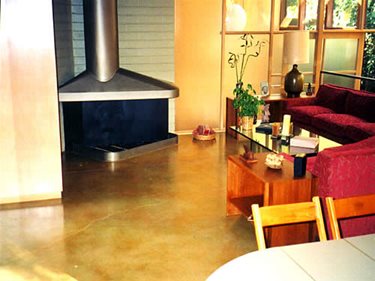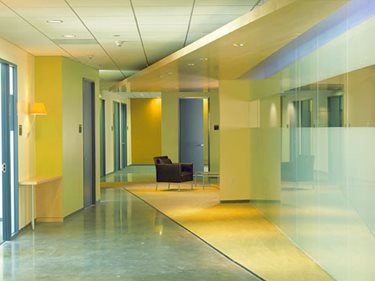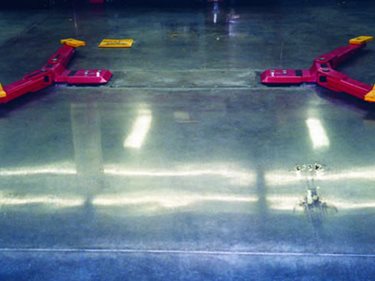- Staining Concrete
- Stamped Concrete
- Concrete Overlays
- Concrete Resurfacing
- Concrete Polishing
- Concrete Dyes
- Colored Concrete
- Indoor Concrete
- Concrete Floors
- Concrete Countertops
- Garage Floor Coatings
- Furniture, Sinks, Fire Bowls
- Basement Floors
- Outdoor Concrete
- Concrete Patios
- Concrete Driveways
- Concrete Pool Decks
- Outdoor Kitchens & Counters
- Outdoor Fireplace
- Concrete Walkways
- Concrete Pavers
- Concrete Walls
- Repair & Maintenance
- Foundation Repair
- Concrete Crack Repair
- Concrete Sealers
- Building with Concrete
- Concrete Homes
- Concrete Basements
- Decorative Concrete
- Fire Resistant
Demmert and Associates: Polishing Up Their Act
Specializes in Polished Concrete FinishesThe term polished concrete may sound like an oxymoron, but for father and son Doug and Greg Demmert, the term has helped put their company on the map in the world of concrete.
Demmert and Associates, located in Glendale, California, specializes in polishing - somewhat of a rarity in the concrete realm. They mechanically polish concrete, leaving it with a lustrous, glass-like finish without using any sort of topical coatings.
"The requests for polished concrete are growing on a monthly basis," said Doug Demmert.
Up until about two years ago, the pair was involved in the marble and stone restoration business. They came to realize that one of the pieces of equipment they purchased worked for polishing concrete. Their dabbling ultimately turned into something much more. What began as a business that concentrated 90 percent of its efforts on marble customers has changed focus; about 85 percent of their business is now polished concrete.
"People are looking for that industrial look," Doug Demmert said. "The high-tech companies and dot-com types were wanting the industrial type of look."
Automobile dealerships are also showing increased interest in polished concrete, Demmert said. In addition to the beautiful, professional look, it is easy to clean, especially when it involves the oils and fluids associated with automobiles.
But polished concrete is moving into the home, too.
Picture an ultra-modern family room with a stainless steel fireplace, wood-frame windows, and rich cranberry-colored furniture. What can top it all off? A gorgeous earth-colored polished concrete floor, which is one of the projects in the gallery of Demmert and Associates.
Or how about a simple, clean kitchen with red and white cabinetry and a classic gray-colored polished concrete floor? They did that, too.
Achieving the glossy, shiny finish is a laborious task involving a process called "lapping," which involves continuously rubbing with a progressively fine abrasive. Silicone carbide is the main type of abrasive used and is commercially available with a magnesite or resin bond in all the shapes required. The final buffing is achieved through the use of either oxalic acid for calcium carbonate or one of the superfine buffing compounds for harder stones.
"There are nine to eleven grinding steps. It's quite laborious," Demmert said.
The first part of the grinding process involves revealing the aggregate through the use of metal diamonds, which is the most important step. Then, resin diamonds are used. Once a sufficient amount of stone is revealed, the concrete is sanded to a fine polish using different grades of sanding stones.
Cement polishing goes back to Roman times when cement mortar was laid down and the decorative stones were placed into the bed by hand to form what is known as a Venetian floor, which was then polished by hand. This ancient process, coupled with modern equipment, is bringing classic looks to businesses and homes throughout the country and specifically Southern California, where Demmert and Associates is headquartered.
Not all floors are candidates for polished concrete, said Demmert. For example, if patches exist in older concrete, an inconsistent look will result. Other floors may have too many holes or dips, which also hinders the polishing process. However, most of the floors pass the evaluation test, Demmert said.
One of the biggest differences between polished concrete and marble is the maintenance factor, Demmert said.
Concrete is very easy to clean while marble typically requires more maintenance. The degree of shine involved also plays a role in how much maintenance is required. Concrete can be polished to resemble a lustrous mirror finish, or it can be polished to a gleaming satin sheen or matte finish.
Demmert and Associates also works in overlays, staining and stained overlays. And they offer cleaning, sealing, floor preparation and terrazzo restoration services.
"Overall, the concrete business is exploding. But not a lot of people are familiar with polishing, but more and more are understanding," Demmert said.
The number of polished concrete specialists across the country is limited, said Demmert, who serves Los Angeles and Ventura counties. One reason, he said, is the cost of the equipment involved.
"The better equipment costs $12,000 to $15,000 to start. And then there's the consumables (in this case, diamonds)," Demmert said. "The marble business is more inexpensive."
Currently Demmert and Associates consists of four employees. Additional temporary workers are pulled in as needed, especially with clean-up duties. All the surrounding walls of a polished concrete site have to be protected because the grinding process is wet, Demmert said.
Plus, it can get expensive to hire someone on a temporary basis - and it isn't because of salary costs.
"You can go through a thousand dollars worth of diamonds if you don't know what you're doing. You can really go through the diamonds," Demmert said.
But for the customer, polished concrete can cost less than a wood floor or a good carpet, said Demmert.
Demmert said the next step in the business is getting the word out about polished concrete and showing it as an attractive alternative to marble in commercial and retail establishments and wood, carpet, and tile in homes.
"We've been trying to do a lot of education and are focusing on exposing our services to designers and architects," Demmert said.
Demmert and Associates' ultimate goal is to make it known that they can transform boring gray concrete into a work of art.
Says Demmert, "It's really just one of those things you have to see with your own eyes."
Demmert and Associates
Doug Demmert
2004 West Mountain Ave
Glendale, CA 91201
(818) 843-5844
Send Mail Now - Click Here
www.demmertandassociates.com
Michele Dawson writes each week on one of the contractor members of The Concrete Network (www.concretenetwork.com). She has written about the home building industry for several years and was on the public affairs staff of the California Building Industry Association.







